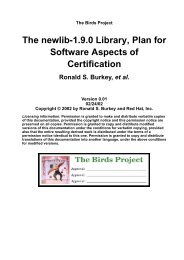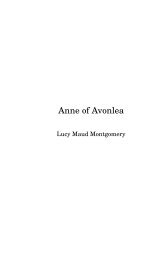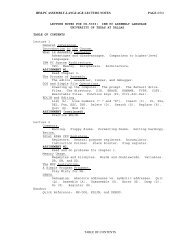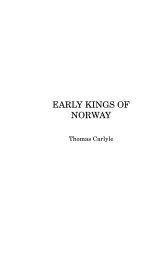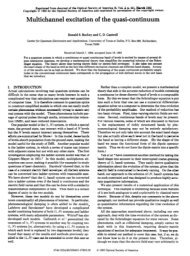Birds PLD, Plan for Hardware Aspects of Certification - Sandroid.org
Birds PLD, Plan for Hardware Aspects of Certification - Sandroid.org
Birds PLD, Plan for Hardware Aspects of Certification - Sandroid.org
Create successful ePaper yourself
Turn your PDF publications into a flip-book with our unique Google optimized e-Paper software.
<strong>Birds</strong> Project<strong>Birds</strong> <strong>PLD</strong>, <strong>Plan</strong> <strong>for</strong> <strong>Hardware</strong><strong>Aspects</strong> <strong>of</strong> <strong>Certification</strong>by Ron BurkeyDocument <strong>Birds</strong><strong>PLD</strong>-PHAC, v1.00 07/09/2006Except <strong>for</strong> the "Bird Man" graphic below, this data is placed in the public domain byits author (Ron Burkey). It may be used or modified <strong>for</strong> any purpose whatever. Thisdata is provided as-is, without any expressed or implied warrantee. The "Bird Man"graphic is copyrighted by Lynn Rothan, and cannot be used without permission.
Table <strong>of</strong> Contents1. PHAC Modification History......................................................................................12. Purpose <strong>of</strong> PHAC Document.....................................................................................13. Documentation Traceability to DO-254 ...................................................................14. PHAC Traceability to DO-254 ..................................................................................25. System Overview........................................................................................................35.1. System Functional Description.........................................................................35.2. System Failure Conditions................................................................................35.3. System Architecture..........................................................................................35.4. Allocation <strong>of</strong> Functions to <strong>Hardware</strong> and S<strong>of</strong>tware .........................................45.5. Allocation <strong>of</strong> Safety Requirements to <strong>Hardware</strong> and S<strong>of</strong>tware........................45.6. Other System Documentation...........................................................................56. <strong>Hardware</strong> Overview...................................................................................................56.1. <strong>Hardware</strong> Functional and Per<strong>for</strong>mance Requirements .....................................56.1.1. Interface to CPU ....................................................................................56.1.1.1. Synopsis ......................................................................................56.1.2. Parallel Output Port................................................................................56.1.2.1. Synopsis ......................................................................................56.1.3. Parallel Input Port ..................................................................................56.1.3.1. Synopsis ......................................................................................66.1.4. Watchdog Timer.....................................................................................66.1.4.1. Synopsis ......................................................................................66.1.5. Peripheral Address Decoder ..................................................................66.1.5.1. Synopsis ......................................................................................66.1.6. Serial Data Routing................................................................................66.1.6.1. Synopsis ......................................................................................66.2. <strong>Hardware</strong> Reliability and Quality Requirements..............................................66.3. <strong>Hardware</strong> Maintenance and Repair Requirements ...........................................76.4. <strong>Hardware</strong> Manufacturability and Assembly Requirements..............................76.5. <strong>Hardware</strong> Testability Requirements..................................................................76.6. <strong>Hardware</strong> Storage and Handling Requirements................................................76.7. Installation Requirements .................................................................................76.8. <strong>Hardware</strong> Items.................................................................................................76.8.1. <strong>Birds</strong><strong>PLD</strong> ...............................................................................................76.9. <strong>Hardware</strong> Architecture......................................................................................76.10. New Technologies...........................................................................................86.11. Fail-Safe Techniques.......................................................................................86.12. Fault Tolerance Techniques.............................................................................8i
6.13. Redundancy Techniques .................................................................................96.14. Partitioning Techniques...................................................................................97. <strong>Certification</strong> Considerations .....................................................................................97.1. Summary <strong>of</strong> the <strong>Certification</strong> Basis ..................................................................97.2. Means <strong>of</strong> Compliance .......................................................................................97.3. <strong>Hardware</strong> Level.................................................................................................97.4. Justification <strong>of</strong> <strong>Hardware</strong> Level ........................................................................98. Life Cycles.................................................................................................................108.1. <strong>Birds</strong><strong>PLD</strong> <strong>Hardware</strong> Development Life Cycle ...............................................108.1.1. Life-Cycle ............................................................................................108.1.1.1. Processes...................................................................................108.1.1.2. Process Procedures....................................................................118.1.1.3. <strong>Hardware</strong> Design Methods .......................................................118.1.1.4. Process Standards......................................................................128.1.1.5. Activities ...................................................................................128.1.1.6. Organizational Responsibilities ................................................128.1.2. Life-Cycle Data....................................................................................128.1.2.1. Data Items .................................................................................129. Additional Considerations ......................................................................................149.1. Previously-Developed <strong>Hardware</strong> ....................................................................149.2. Commercial Off-the-Shelf <strong>Hardware</strong>..............................................................149.3. Product Service-History..................................................................................149.4. Tool Assessment and Qualification.................................................................149.5. Alternative Methods <strong>of</strong> Compliance...............................................................1510. <strong>Certification</strong> Schedule............................................................................................1511. Glossary ..................................................................................................................15ii
1. PHAC Modification HistoryRevision 0.00-0.99Uncontrolled drafts.2. Purpose <strong>of</strong> PHAC DocumentThis is a standard "<strong>Plan</strong> <strong>for</strong> <strong>Hardware</strong> <strong>Aspects</strong> <strong>of</strong> <strong>Certification</strong>" document,corresponding to the guidelines in RTCA DO-254. Among other things, it provides asystem overview, a hardware overview, a description <strong>of</strong> the certification basis andjustification, a description <strong>of</strong> the hardware development life cycle and data items, and acertification schedule.3. Documentation Traceability to DO-254<strong>Birds</strong><strong>PLD</strong>-PHAC<strong>Plan</strong> <strong>for</strong> <strong>Hardware</strong> <strong>Aspects</strong> <strong>of</strong> <strong>Certification</strong> DO-254 10.1.1<strong>Birds</strong><strong>PLD</strong>-HDP<strong>Hardware</strong> Design <strong>Plan</strong> DO-254 10.1.2<strong>Birds</strong><strong>PLD</strong>-HVVP<strong>Hardware</strong> Validation and Verification <strong>Plan</strong>DO-254 10.1.3 and10.1.4<strong>Birds</strong><strong>PLD</strong>-HCMP<strong>Hardware</strong> Configuration Management <strong>Plan</strong> DO-254 10.1.5- <strong>Hardware</strong> Process Assurance <strong>Plan</strong>, not neededat assurance level C- Requirements Standards, not needed atassurance level C- <strong>Hardware</strong> Design Standards, not needed atassurance level C- Validation and Verification Standards, notneeded at assurance level CDO-254 10.1.6DO-254 10.2.1DO-254 10.2.2DO-254 10.2.31
<strong>Birds</strong> <strong>PLD</strong>, PHAC- <strong>Hardware</strong> Archive Standards, not needed at DO-254 10.2.4assurance level C<strong>Birds</strong><strong>PLD</strong>-HRD<strong>Hardware</strong> Requirements Data DO-254 10.3.1<strong>Birds</strong><strong>PLD</strong>-HDRD<strong>Hardware</strong> Design Representation Data DO-254 10.3.2<strong>Birds</strong><strong>PLD</strong>-HTPR<strong>Hardware</strong> Test Processes and Results DO-254 10.4.1,10.4.4, and 10.4.5- Review Checklists DO-254 10.4.2 and10.4.3<strong>Birds</strong><strong>PLD</strong>-VVDValidation and Verification Data (collectedfilled-out HTPR and Review Checklists)DO-254 10.4<strong>Birds</strong><strong>PLD</strong>-HATC<strong>Hardware</strong> Acceptance Test Criteria DO-254 10.5- Problem Reports DO-254 10.6- <strong>Hardware</strong> Configuration Management DO-254 10.7Records, combined with Validation andVerification Data (<strong>Birds</strong><strong>PLD</strong>-VVD)- <strong>Hardware</strong> Process Assurance Records, DO-254 10.8combined with Validation and VerificationData (<strong>Birds</strong><strong>PLD</strong>-VVD)<strong>Birds</strong><strong>PLD</strong>-HAS<strong>Hardware</strong> Accomplishment Summary DO-254 10.94. PHAC Traceability to DO-254This document <strong>org</strong>anizes data in a manner consistent with DO-254 section 10.1.1,including the ordering <strong>of</strong> data and the section headings. In practice, the match is soobvious that there would be no benefit in having explicit section-by-section traceabilityto DO-254.2
5. System Overview<strong>Birds</strong> <strong>PLD</strong>, PHAC5.1. System Functional DescriptionThe system being developed is an crew-warning or annunciator system, in whichactivation <strong>of</strong> various electrical inputs causes annuciation <strong>of</strong> aural warnings. The system,referred to as the <strong>Birds</strong> Crew Warning System ("<strong>Birds</strong>CWS") is CPU based.However, this documentation deals only with the Programmable Logic Device (<strong>PLD</strong>)sub-system <strong>of</strong> the annunciator. The <strong>PLD</strong> sub-system, referred to as the "<strong>Birds</strong><strong>PLD</strong>", ispresent as a derived requirement. The <strong>Birds</strong>CWS system requirements call <strong>for</strong> the use<strong>of</strong> a hardware architecture which is reusable across differing hardware generations oreven to projects other than the <strong>Birds</strong>CWS, in order to increase reusability <strong>of</strong> s<strong>of</strong>twarelibraries and documentation. Thus, as a derived requirement, the <strong>Birds</strong><strong>PLD</strong> is providedto help maintain constancy <strong>of</strong> hardware/s<strong>of</strong>tware interfaces.Considered as a system <strong>of</strong> itself, the <strong>Birds</strong><strong>PLD</strong> provides the following capabilities:1. It interfaces to the CPU via the CPU’s data/address bus.2. It provides an 8-bit latched parallel-data output port.3. It provides an 8-bit input parallel-data port.4. It provides a watchdog timer which can be disabled via a signal intended to becontrolled by a hardware jumper.5. It provides decoding <strong>for</strong> some peripheral devices.6. It provides <strong>for</strong> flexible routing <strong>of</strong> serial data on the basis <strong>of</strong> electrical signalsintended to be controlled via DIP switches.Although the <strong>Birds</strong>CWS CPU may itself have some <strong>of</strong> these facilities embedded withinit, using the <strong>Birds</strong><strong>PLD</strong> rather than the embedded capabilities <strong>of</strong> the CPU allows muchmore flexibility in choice <strong>of</strong> CPU without s<strong>of</strong>tware change. This is because it is mucheasier to replace the CPU with one having a 100% compatible instruction set ratherthan one with 100% compatible peripheral devices.5.2. System Failure ConditionsThere are no identifiable failure conditions <strong>of</strong> the <strong>Birds</strong><strong>PLD</strong> sub-system.3
5.3. System Architecture<strong>Birds</strong> <strong>PLD</strong>, PHAC<strong>Birds</strong>CWS Block Diagram5.4. Allocation <strong>of</strong> Functions to <strong>Hardware</strong> andS<strong>of</strong>twareThe <strong>Birds</strong><strong>PLD</strong> is a derived requirement, implemented entirely in hardware.5.5. Allocation <strong>of</strong> Safety Requirements to <strong>Hardware</strong>4
and S<strong>of</strong>twareThere are no safety requirements associated with the <strong>Birds</strong><strong>PLD</strong>.<strong>Birds</strong> <strong>PLD</strong>, PHAC5.6. Other System DocumentationThe <strong>Birds</strong>CWS (<strong>for</strong> which the <strong>Birds</strong><strong>PLD</strong> is a derived requirement) system requirementsare described in <strong>Birds</strong> Project document <strong>Birds</strong>CWS-SCD.6. <strong>Hardware</strong> Overview6.1. <strong>Hardware</strong> Functional and Per<strong>for</strong>manceRequirements6.1.1. Interface to CPU6.1.1.1. SynopsisRegisters internal to the <strong>Birds</strong><strong>PLD</strong> interface to the CPU via the CPU’saddress/data/control bus. Each <strong>of</strong> these internal registers is 8 bits in width. A singlechip-select signal from the CPU is used, and the <strong>Birds</strong><strong>PLD</strong> internally decodes 4 addresssignals and a read/write control line to select the specific registers and the datadirection.6.1.2. Parallel Output Port6.1.2.1. SynopsisThe <strong>Birds</strong><strong>PLD</strong> has a single internal 8-bit register (see "Interface to CPU" above) which,upon being written to by the CPU, latches the data and delivers it to 8 discrete outputpins <strong>of</strong> the <strong>Birds</strong><strong>PLD</strong>. The register may also be read by the CPU, in which case thecontents <strong>of</strong> the latch are returned.5
6.1.3. Parallel Input Port<strong>Birds</strong> <strong>PLD</strong>, PHAC6.1.3.1. SynopsisThe <strong>Birds</strong><strong>PLD</strong> has an 8-bit register (see "Interface to CPU" above) which can beinterrogated by the CPU to determine the state <strong>of</strong> 8 discrete input signals to the<strong>Birds</strong><strong>PLD</strong>.6.1.4. Watchdog Timer6.1.4.1. SynopsisThe <strong>Birds</strong><strong>PLD</strong> implements a watchdog timer circuit which must be refreshedperiodically or else it times out and generates an output signal intended to be used as asystem reset. Refreshing the watchdog involves the CPU writing two predeterminedvalued to two internal 8-bit registers (see "Interface to CPU" above) <strong>of</strong> the <strong>Birds</strong><strong>PLD</strong>.6.1.5. Peripheral Address Decoder6.1.5.1. SynopsisThe <strong>Birds</strong><strong>PLD</strong> provides address decoding <strong>for</strong> 8 peripheral devices external to the CPUand <strong>Birds</strong><strong>PLD</strong>. It employs the same chip-select as <strong>for</strong> "Interface to CPU" above,conditions that chip-select by detecting that the address lines are in 8 different addressranges, and outputs 8 sets <strong>of</strong> control signals.6.1.6. Serial Data Routing6.1.6.1. SynopsisThe <strong>Birds</strong><strong>PLD</strong> accepts 4 serial-data signals as inputs and outputs 4 serial-data signalsas outputs. For each <strong>of</strong> the 4 outputs, there are 2 input signals determining which <strong>of</strong> the4 inputs is routed to the output.6
<strong>Birds</strong> <strong>PLD</strong>, PHAC6.2. <strong>Hardware</strong> Reliability and Quality RequirementsNone.6.3. <strong>Hardware</strong> Maintenance and RepairRequirementsNone.6.4. <strong>Hardware</strong> Manufacturability and AssemblyRequirementsNone.6.5. <strong>Hardware</strong> Testability RequirementsNone.6.6. <strong>Hardware</strong> Storage and Handling RequirementsNone.6.7. Installation RequirementsNone.6.8. <strong>Hardware</strong> Items6.8.1. <strong>Birds</strong><strong>PLD</strong>The sole hardware item covered by this documentation is the <strong>Birds</strong><strong>PLD</strong> itself.7
6.9. <strong>Hardware</strong> Architecture<strong>Birds</strong> <strong>PLD</strong>, PHAC<strong>Birds</strong><strong>PLD</strong> Block Diagram6.10. New TechnologiesNone.6.11. Fail-Safe TechniquesNone.8
6.12. Fault Tolerance TechniquesNone.<strong>Birds</strong> <strong>PLD</strong>, PHAC6.13. Redundancy TechniquesNone.6.14. Partitioning TechniquesEach function <strong>of</strong> the <strong>Birds</strong><strong>PLD</strong> is implemented at a DO-254 assurance level <strong>of</strong> C. Thusthere is no partitioning <strong>of</strong> assurance levels.7. <strong>Certification</strong> Considerations7.1. Summary <strong>of</strong> the <strong>Certification</strong> BasisPlease reference the documentation <strong>of</strong> the parent <strong>Birds</strong>CWS project(<strong>Birds</strong>CWS-PHAC).7.2. Means <strong>of</strong> ComplianceRTCA DO-254 is used as the means <strong>of</strong> compliance, per FAA AC20-152.7.3. <strong>Hardware</strong> LevelThe assurance level is C. (Refer to RTCA DO-254, Table 2-1.)7.4. Justification <strong>of</strong> <strong>Hardware</strong> LevelPlease reference the documentation <strong>of</strong> the parent <strong>Birds</strong>CWS project(<strong>Birds</strong>CWS-PHAC).9
8. Life Cycles<strong>Birds</strong> <strong>PLD</strong>, PHAC8.1. <strong>Birds</strong><strong>PLD</strong> <strong>Hardware</strong> Development Life Cycle8.1.1. Life-Cycle8.1.1.1. ProcessesThe <strong>Hardware</strong> Design <strong>Plan</strong> (HDP) describes the life-cycle processes in detail. Whatfollows is a brief summary.The canonical life-cycle processes envisaged by DO-254 Chapter 3 are used. Thefollowing processes occur in sequential order:• <strong>Plan</strong>ning Process• Requirements Capture Process, wherein system requirements are allocated tohardware requirements, and traceability between system requirements and hardwarerequirements is established.• Conceptual Design Process, wherein hardware requirements are developed in detail.• Detailed Design Process, wherein specific design artifacts such as schematiccaptures, bills <strong>of</strong> material, or HDL source code are developed from the conceptualdesign data.• Implementation Process, wherein detailed design data is converted to physicalhardware such as circuit boards or ASICs.• Validation and Verification Process. The "validation" portion <strong>of</strong> this process actuallyis concurrent with all other process, and only the "verification" part is sequential.However, validation occurs by means <strong>of</strong> review checklists called out by processchecklists <strong>of</strong> the other processes. In other words, validation is really integrated withother processes rather than being a separate process <strong>of</strong> itself.• Product Transition Process, wherein manufacturing and repair data is created,traceability with detailed design data is established, and acceptance occurs.The following processes are concurrent with the sequential processes:• <strong>Hardware</strong> Configuration Management Process• <strong>Hardware</strong> Process Assurance10
<strong>Birds</strong> <strong>PLD</strong>, PHAC• <strong>Certification</strong> Liaison Process8.1.1.2. Process ProceduresThe <strong>Hardware</strong> Design <strong>Plan</strong> (HDP) describes the process procedures in detail. Whatfollows is a brief summary.Each <strong>of</strong> the hardware life-cycle process (<strong>Plan</strong>ning, Requirements Capture, etc.) has anassociated checklist which itemizes each <strong>of</strong> the steps required to complete that process.The checklists are separate documents, called out in the <strong>Hardware</strong> Development <strong>Plan</strong>(HDP). The checklists include not only the steps specific to the associated processes,but also all <strong>of</strong> the Validation Process, <strong>Hardware</strong> Configuration Management Process,and <strong>Certification</strong> Liaison steps which are relevant, thus obviating most <strong>of</strong> the need <strong>for</strong>separate Validation, <strong>Hardware</strong> Configuration Management, and <strong>Certification</strong> LiaisonProcesses. Additionally, the checklists contain some, but not all, associated <strong>Hardware</strong>Process Assurance tasks.At the outset <strong>of</strong> any given life-cycle process, the lead hardware developer obtains ablank copy <strong>of</strong> the process checklist. As each step <strong>of</strong> the process is per<strong>for</strong>med, thehe/she initials and dates that step. When all steps are complete, or when a regression ismade to an earlier life-cycle process, the completed process becomes part <strong>of</strong> the<strong>Hardware</strong> Process Assurance Records (HPAR), which <strong>for</strong> this project are combinedwith the Validation and Verification Data (VVD). When a regression to an earlierlife-cycle process is made, the lead developer obtains a new, blank copy <strong>of</strong> the earlierlife-cycle process.Blank life-cycle process checklists are reviewed and approved, prior to use, by the leadhardware developer. In case the life-cycle processes are identical to those inpreviously-developed hardware at the same assurance level, process checklists from theprior project can be used unchanged.<strong>Hardware</strong> Process Assurance (HPA) differs from the other life-cycle processes, in thatit does not have a process checklist. Rather the process checklists lists all relevant HPAtasks. Since DO-254 does not require <strong>for</strong>mal HPA at assurance level C, all HPAactivities are per<strong>for</strong>med by the lead hardware developer.8.1.1.3. <strong>Hardware</strong> Design Methods<strong>Hardware</strong> requirements, design, test procedures, and configuration data are capturedand interrelated using a s<strong>of</strong>tware tool called Do178Builder.11
<strong>Birds</strong> <strong>PLD</strong>, PHACConceptual design data is converted to detailed design data by creating VHDL sourcecode, and then compiling that code using tools provided by the manufacturer <strong>of</strong> the<strong>PLD</strong> device used.8.1.1.4. Process StandardsNone.8.1.1.5. ActivitiesThe activities are defined by the <strong>Hardware</strong> Design <strong>Plan</strong> (<strong>Birds</strong><strong>PLD</strong>-HDP). In brief,each development process (<strong>Plan</strong>ning, Requirements Capture, Conceptual Design, etc.)has an associated checklist <strong>of</strong> activities, managed by the lead hardware developer. Thechecklist <strong>for</strong> each development process is completed be<strong>for</strong>e proceeding to the nextdevelopment process. The process checklists include: development <strong>of</strong> data items,review and release <strong>of</strong> data items, etc.8.1.1.6. Organizational ResponsibilitiesThe <strong>Birds</strong><strong>PLD</strong> is solely developed by Ron Burkey <strong>of</strong> the <strong>Birds</strong> Project.8.1.2. Life-Cycle Data8.1.2.1. Data Items<strong>Birds</strong><strong>PLD</strong>-PHAC<strong>Plan</strong> <strong>for</strong> <strong>Hardware</strong> <strong>Aspects</strong> <strong>of</strong><strong>Certification</strong><strong>Plan</strong>ningSubmit<strong>Birds</strong><strong>PLD</strong>-HDP<strong>Hardware</strong> Design <strong>Plan</strong> <strong>Plan</strong>ning Records<strong>Birds</strong><strong>PLD</strong>-HVVP<strong>Hardware</strong> Validation and Verification<strong>Plan</strong><strong>Plan</strong>ningSubmit12
<strong>Birds</strong> <strong>PLD</strong>, PHAC<strong>Birds</strong>-HCMP<strong>Hardware</strong> Configuration Management<strong>Plan</strong><strong>Plan</strong>ningRecords- Note that a <strong>Hardware</strong> ProcessAssurance <strong>Plan</strong> is not needed atassurance level C.- Note that Requirements Standards arenot needed at assurance level C.- Note that <strong>Hardware</strong> Design Standardsare not needed at assurance level C.- Note that Validation and VerificationStandards are not needed at assurancelevel C.- Note that <strong>Hardware</strong> Archive Standardsare not needed at assurance level C.<strong>Birds</strong><strong>PLD</strong>- <strong>Hardware</strong> Requirements DataHRD- Not used- Not used- Not used- Not used.- Not used.RequirementsCaptureRecords<strong>Birds</strong><strong>PLD</strong>-HDRD<strong>Hardware</strong> Design Representation DataConceptualDesignRecords- Detailed Design Data Detailed Design Submittop-leveldrawingonly<strong>Birds</strong><strong>PLD</strong>-HTPR<strong>Hardware</strong> Test Processes and Results Verification Records<strong>Birds</strong><strong>PLD</strong>-VVDValidation and Verification DataValidation andVerificationRecords<strong>Birds</strong><strong>PLD</strong>-HATC<strong>Hardware</strong> Acceptance Test Criteria Verification Records<strong>Birds</strong><strong>PLD</strong>-HAS<strong>Hardware</strong> Accomplishment SummaryProduct Transition Submit13
<strong>Birds</strong> <strong>PLD</strong>, PHAC- <strong>Hardware</strong> Configuration ManagementRecords are combined with theValidation and Verification Data(<strong>Birds</strong><strong>PLD</strong>-VVD)- <strong>Hardware</strong> Process Assurance Recordsare combined with the Validation andVerification Data (<strong>Birds</strong><strong>PLD</strong>-VVD)ConfigurationManagementRecordsProcess Assurance Records9. Additional Considerations9.1. Previously-Developed <strong>Hardware</strong>None. Note that the <strong>Birds</strong><strong>PLD</strong> is being developed in a manner that presumes it willeventually be possible to use it as previously-developed hardware in other projects.9.2. Commercial Off-the-Shelf <strong>Hardware</strong>None.9.3. Product Service-HistoryNone.9.4. Tool Assessment and QualificationOutputs <strong>of</strong> all tools are checked as part <strong>of</strong> the Verification Process, and there<strong>for</strong>e thetools themselves do not need qualification.Note, however, that the traceability data is automatically generated by thedocumentation tool (Do178Builder) used to manage the requirements, the design data,and the test procedures, and that it would be very convenient to be able to use this data14
<strong>Birds</strong> <strong>PLD</strong>, PHACas-is without the burden <strong>of</strong> having to check it. Since the Do178Builder tool is notqualified <strong>for</strong> this purpose initially, manual checks <strong>of</strong> the traceability data will have to bemade <strong>for</strong> the initial release <strong>of</strong> the <strong>Birds</strong><strong>PLD</strong>. However, this initial check shall qualifythe Do178Builder tool (in the version used <strong>for</strong> the initial release) <strong>for</strong> generation <strong>of</strong>traceability data in later releases <strong>of</strong> the <strong>Birds</strong><strong>PLD</strong> or other <strong>Birds</strong> Projects hardwaredevelopment.9.5. Alternative Methods <strong>of</strong> ComplianceNo methods <strong>of</strong> compliance other than those <strong>of</strong> DO-254 are used.10. <strong>Certification</strong> ScheduleReference the documentation <strong>of</strong> the parent project (<strong>Birds</strong>CWS-PHAC). Activitiesrelated solely to the <strong>Birds</strong><strong>PLD</strong> sub-project are as follows.Date Milestone CommentAugust 2006 DER accepts PHACSeptember 2006 HDP, HVVP, HCMP readyOctober 2006 HRD, HDRD readyNovember 2006 Detailed design and implementationcompleteDecember 2006 Test procedures (HTPR) completeJanuary 2007 Testing completeFebruary 2007 DER sign<strong>of</strong>f, <strong>Birds</strong><strong>PLD</strong> released11. GlossaryASIC. Application Specific Integrated Circuit.CAD. Computer Aided Design.CAM. Computer Aided Manufacturing.COTS. Commercial Off-The-Shelf.15
C<strong>PLD</strong>. Complex Programmable Logic Device.DER. Designated Engineering Representative.FAA. Federal Aviation Administration.FPGA. Field Programmable Gate Array.HARS. <strong>Hardware</strong> Archiving Standards.HATC. <strong>Hardware</strong> Acceptance Test Criteria.HAS. <strong>Hardware</strong> Accomplishment Summary.HC1 and HC2. <strong>Hardware</strong> Control Categories 1 and 2.HCM. <strong>Hardware</strong> Configuration Management.HCMP. <strong>Hardware</strong> Configuration Management <strong>Plan</strong>.HCMR. <strong>Hardware</strong> Configuration Management Records.<strong>Birds</strong> <strong>PLD</strong>, PHACHDL. <strong>Hardware</strong> Description Language or <strong>Hardware</strong> Design Language. For example,Verilog, VHDL, Abel.HDP. <strong>Hardware</strong> Design <strong>Plan</strong>.HDRD. <strong>Hardware</strong> Design Representation Data.HDS. <strong>Hardware</strong> Design Standards.HPA. <strong>Hardware</strong> Process Assurance.HPAP. <strong>Hardware</strong> Process Assurance <strong>Plan</strong>.HPAR. <strong>Hardware</strong> Process Assurance Records.HRD. <strong>Hardware</strong> Requirements Data.HTPR. <strong>Hardware</strong> Test Procedures and Results.HVVP. <strong>Hardware</strong> Validation and Verification <strong>Plan</strong>.ICD. Interface Control Drawing.LRU. Line Replaceable Unit.PCB. Printed Circuit Board. Same as PWB. I.e., a "bare" circuit board as fabricated,prior to assembly with electronic components.PHAC. <strong>Plan</strong> <strong>for</strong> <strong>Hardware</strong> <strong>Aspects</strong> <strong>of</strong> <strong>Certification</strong>.<strong>PLD</strong>. Programmable Logic Device.PR. Problem Report(s).16
<strong>Birds</strong> <strong>PLD</strong>, PHACPWA. Printed Wire Assembly. I.e., a PCB or PWB after assembly with electroniccomponents.PWB. Printed Wire Board. Same as PCB. I.e., a "bare" circuit board as fabricated, priorto assembly with electronic components.RTCA. Once upon a time, Radio Technical Commission <strong>for</strong> Aeronautics. Now,apparently, simply "RTCA, Inc." without being intended as an acronym.SCD. Specification Control Drawing.RS. Requirements Standards.VVS. Validation and Verification Standards.17



